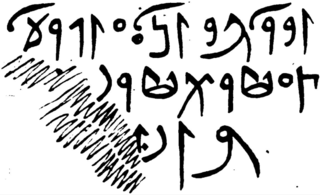Related Research Articles

Tifinagh is a script used to write the Berber languages. Tifinagh is descended from the ancient Libyco-Berber alphabet. The traditional Tifinagh, sometimes called Tuareg Tifinagh, is still favored by the Tuareg Berbers of the Sahara desert in southern Algeria, northeastern Mali, northern Niger and northern Burkina Faso for writing the Tuareg Berber language. Neo-Tifinagh is an alphabet developed by Berber Academy to adopt Tuareg Tifinagh for use with Kabyle; it has been since modified for use across North Africa.
Zenaga is a Berber language on the verge of extinction currently spoken in Mauritania and northern Senegal by a few hundred people. Zenaga Berber is spoken as a mother tongue from the town of Mederdra in southwestern Mauritania to the Atlantic coast and in northern Senegal. The language is recognized by the Mauritanian government.
The Zenati languages are a branch of the Northern Berber language family of North Africa. They were named after the medieval Zenata Berber tribal confederation. They were first proposed in the works of French linguist Edmond Destaing (1915) (1920–23). Zenata dialects are distributed across the central Berber world (Maghreb), from northeastern Morocco to just west of Algiers, and the northern Sahara, from southwestern Algeria around Bechar to Zuwara in Libya. The most widely spoken Zenati languages are Tmazight of the Rif in northern Morocco and Tashawit Berber in northeastern Algeria, each of which have over 3 million speakers.

The Ghomara language is a Northern Berber language spoken in Morocco. It is the mother tongue of the Ghomara Berbers, who total around 10,000 people. Ghomara Berber is spoken on the western edge of the Rif, among the Beni Bu Zra and Beni Mansur tribes of the Ghomara confederacy. Despite being listed as endangered, it is still being passed on to children in these areas.

The Ghomara are a group of tribes in northern Morocco of about 12,000 people, living between the rivers Oued Laou and Ouringa, east of Chefchaouen and south of Tetouan, in the Western Rif. The river Tiguisas runs through their territory.
The Jarawa or Jrāwa were a nomadic Berber Zenata tribal confederacy, who probably converted to Christianity. The Berber tribe ruled in northwest Africa before and during the 7th century. Under queen Dihya, the tribe led the Berber resistance against the Umayyad Islamic invasion in the late 7th century.

During the Iron Age and classical antiquity, Libya referred to modern-day Africa west of the Nile river. Greek and Roman geographers placed the dividing line between Libya/Africa and Asia at the Nile.

The Berber calendar is the agricultural calendar traditionally used by Berbers,. The calendar is utilized to regulate the seasonal agricultural works.
The Banu Ifran or Ifranids, were a Zenata Berber tribe prominent in the history of pre-Islamic and early Islamic North Africa. In the 8th century, they established a kingdom in the central Maghreb, with Tlemcen as its capital.

The Quinquegentiani were a Classical Age Berber tribal confederation inhabiting the lands between the cities of Saldae and Rusuccuru, a region which is now known as Kabylia. Their territory laid at the eastern border of the Roman province of Mauretania Caesariensis, and although they were officially under Roman rule, they acted very autonomously.

Encyclopédie berbère is a French-language encyclopaedia dealing with subjects related to the Berber peoples, published both in print editions and in a partial online version.

Gabriel Camps was a French archaeologist and social anthropologist, the founder of the Encyclopédie berbère and is considered a prestigious scholar on the history of the Berber people.

Zayanes are a Berber population inhabiting the Khenifra region, located in the central Middle Atlas mountains of Morocco.

Jedars are thirteen Berber mausoleums located south of Tiaret city in Algeria. The name is derived from the Arabic: جدار jidār (wall), which is used locally to refer to ancient monumental ruins. The pre-Islamic tombs date from late antiquity.

Gurzil was an important ancient Berber deity. He is known from two sources, the Latin poem Iohannis by the 6th-century Christian Roman poet Corippus and a Neo-Punic inscription from Lepcis Magna.

Berbère Télévision is a TV channel broadcasting in Tamazight language from Montreuil. Berbère Télévision was set up by BRTV Group.
Salem Chaker is an Algerian linguist. A specialist in Berber linguistics, he is recognized as the "dean" of modern Berber studies.

Amlu, also spelled as amlou, is a spread of Moroccan cuisine. It consists of argan oil, almonds and honey. The almonds are toasted, which are then crushed and kneaded with honey and argan oil. Amlou is usually served for breakfast or afternoon tea with pancakes and pastries.

The Mauro-Roman Kingdom was an independent Christian Berber kingdom centred in the capital city of Altava which controlled much of the ancient Roman province of Mauretania Caesariensis. The kingdom was first formed in the fifth century as Roman control over the province weakened and Imperial resources had to be concentrated elsewhere, notably in defending the Roman Italy itself from invading Germanic tribes.

Jewelleryof the Berber cultures is a historical style of traditional jewellery that was worn by women mainly in rural areas of the Maghreb region in North Africa and inhabited by indigenous Berber people. Following long social and cultural traditions, Berber or other silversmiths in Morocco, Algeria and neighbouring countries created intricate jewellery with distinct regional variations. In many towns and cities, there were Jewish silversmiths, who produced both jewellery in specific Berber styles as well as in other styles, adapting to changing techniques and artistic innovations.